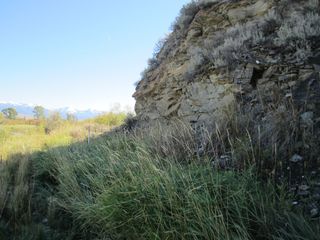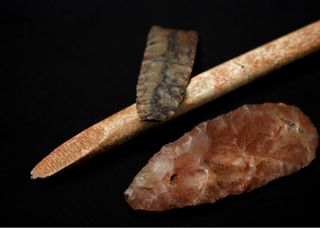Prehistoric Boy May Be Native American 'Missing Link'

A prehistoric boy's DNA now suggests that ancient toolmakers long thought of as the first Americans may serve as a kind of "missing link" between Native Americans and the rest of the world, researchers say.
The findings reveal these prehistoric toolmakers are the direct ancestors of many contemporary Native Americans, and are closely related to all Native Americans.
Scientists investigated a prehistoric culture known as the Clovis, named after sites discovered near Clovis, N.M. Centuries of cold, nicknamed the "Big Freeze," helped wipe out the Clovis, as well as most of the large mammals in North America. The artifacts of the Clovis are found south of the giant ice sheets that once covered Canada, in most of North America, though not in South America.
The stone tools of the Clovis, such as distinctive fluted or grooved spear points, date to about 12,600 to 13,000 years ago, making them the oldest widespread set of artifacts in North America. For most of the past 50 years, archaeologists thought the Clovis were the first Americans, but investigators recently uncovered evidence that humans were in the New World before Clovis, at least more than 14,000 years ago.

Researchers focused on bones unearthed by construction next to a rock cliff on the land of the Anzick family in central Montana. [See Images of Clovis Culture Artifacts]
"I was just a small child in 1968 when the only Clovis burial site was identified accidentally on my parents' property in Wilsall, Montana,"study co-author Sarah Anzick at Rocky Mountain Laboratories in Hamilton, Mont., told Live Science.
Anzick boy
Sign up for the Live Science daily newsletter now
Get the world’s most fascinating discoveries delivered straight to your inbox.
The so-called Anzick skeleton was found with about 125 artifacts, including Clovis fluted spear points and tools made from antlers, and covered in red ochre, a type of mineral.
"This is the oldest burial in North America, and the only known Clovis burial,"study co-author Michael Waters at Texas A&M University in College Station told Live Science.
"Genetic studies tell us these were the remains of a boy," Waters said. "Physical anthropological studies tell us he was 1 to 1.5 years old, and radiocarbon dating tells us this burial took place about 12,600 years ago, at the end of the Clovis era." It remains uncertain how this child died.
The scientists analyzed DNA from the bones. They managed to recover the first complete genome sequence of an ancient North American, despite how badly preserved the DNA in the remains were. [Top 10 Mysteries of the First Humans]
"We found the genome of this boy is closely related to all Native Americans of today than to any other peoples around the world," study co-author Eske Willerslev of the University of Copenhagen in Denmark told Live Science. "We can also see from the genome study that this Anzick population is the direct ancestor to many Native Americans to date. As such, our study is in agreement with the view that present-day Native Americans are direct descendants of the first peoples in the Americas."
Shane Doyle, study co-author at Montana State University, said, "I feel like this discovery confirms what tribes never really doubted — that we've been here since time immemorial and that all of the artifacts in the ground are remnants of our direct ancestors."
It was surprising that the Anzick lineage "is directly ancestral to so many peoples in the Americas," Willerslev said. "We don't have genetic information by any means from all tribes, but a very, very broad estimate suggests 80 percent derives from the Anzick group, which is an amazing result — almost like a missing link, if you want."
The first Clovis
The origin of the Clovis was uncertain. Although it was generally believed the Clovis ultimately derived from Asia, others suggested the ancestors of the Clovis actually may have come from southwestern Europe between 21,000 and 17,000 years ago, the so-called "Solutrean hypothesis."
This new research "has settled the long-standing debate about the origins of the Clovis," Willerslev said. "We can say the Solutrean theory suggesting Clovis originated from people in Europe doesn't fit our results."
These genetic findings "seem to fit quite nicely with an early occupation of the Americas about 2,000 years before the onset of Clovis," Waters said. "If you look at credible evidence for the peopling of the Americas, most date from a period 15,000 to 14,500 years ago," although "there are claims of occupation 20,000 to 30,000 years ago."
The scientists also discovered evidence of a deep genetic divergence that occurred between northern Native American groups and those from Central and South America that happened before the Clovis era. Specifically, although most South Americans and Mexicans are part of the Anzick lineage and therefore Clovis, northern Canadian groups belong to another lineage.
Intriguingly, while the Anzick skeleton dates back 12,600 years to the twilight of the Clovis era, the antler tools date back about 13,000 years to the dawn of the Clovis era. In addition, "genetic work shows the antler tools were made of elk, a rare animal in the plains at that time," Waters said. The difference in age between the skeleton and the antler tools, as well as the fact that the antlers were from a rare animal, suggest the antler tools were "very special ritual objects passed down for generations."
The remains will be reburied.
"We're excited and honored to work with the tribes and plan a reburial ceremony to lay this child to rest with the respect such an important part of human history deserves," Anzick said. The ceremony is planned for late spring or early summer of this year.
"The genetic information provided by the Anzick boy is part of the larger story of modern humans," Waters said. "We know that modern humans originated in Africa and 50,000 years ago spread rapidly over Europe and Asia. The last continents to be explored and settled by modern humans were the Americas. In essence, the Anzick boy tells us about the epic journey of our species."
The scientists detailed their findings in the Feb. 13 issue of the journal Nature.
Follow Live Science @livescience, Facebook & Google+. Original article on Live Science.

Most Popular


